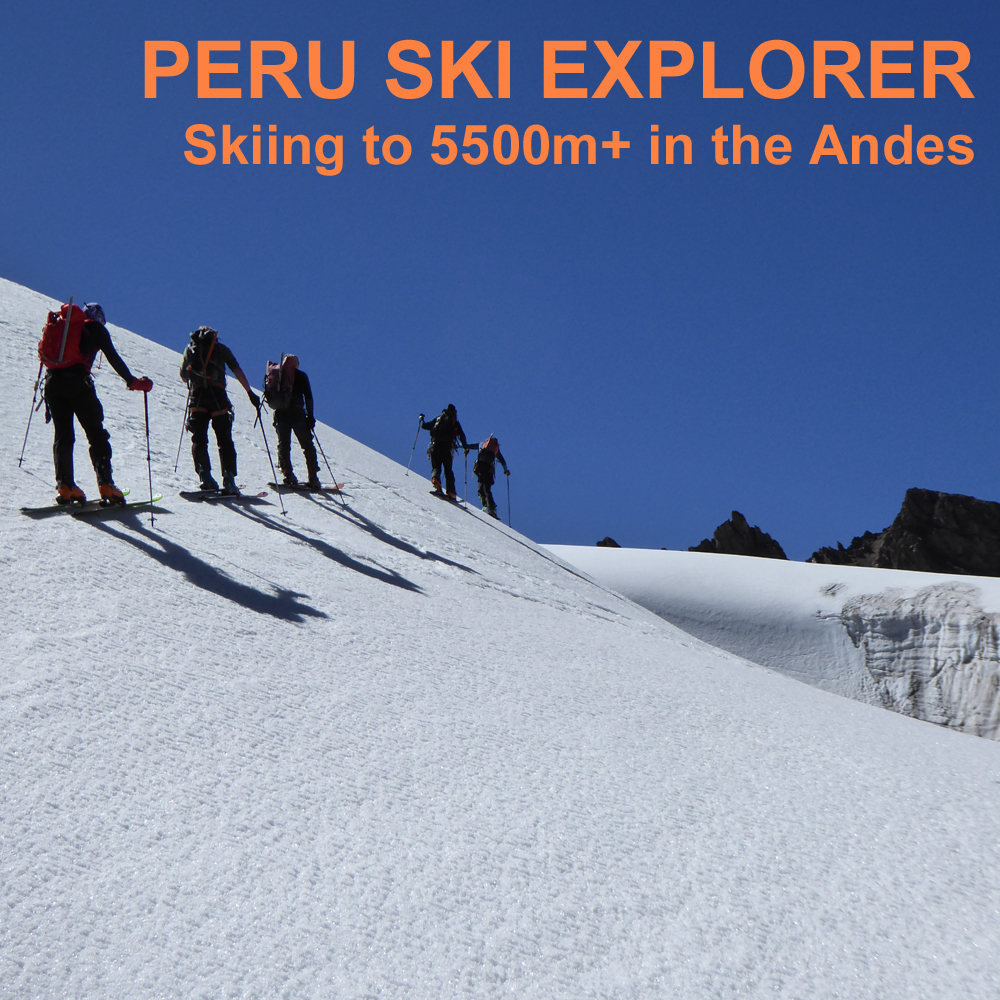 |
Dates | April to June |
| Duration | 18 days | |
| Grade | 2B | |
|
ANDES leadership fee about £2600 |
||
Exploratory Ski Mountaineering in Southern Peru.
Not currently scheduled. Ran for the first time in May 2025.
PRICES & COSTS
All are per person.
"Andes" Leadership Fee (includes leaders expenses) -- about £2600
Estimated Airfares -- £900
Estimated Trek & Travel Costs in Peru -- £400
Estimated Accommodation & Meals -- £400
ESTIMATED TOTAL COST per person -- £4300
INTRODUCTION
This itinerary visits a country and mountain range we know very well to explore some of the highest mountains on skis. We'll keep the itinerary fairly flexible to make the best use of snow conditions for ski-mountaineering, but the plan is to ski one high 5600m+ peak after an initial phase of skiing several 5000-5500m peaks.
The expedition will fly out to Cuzco in southern Peru. Cuzco (or Cusco) was the ancient capital of the Inca Empire and now a major tourist destination. We are offering two options here. The first is to spend three days in this city and visiting nearby tourist attractions to acclimatise to the altitude. Cuzco is at an altitude of 3500m. This will also include time for you to visit the nearby ruins of Machu Picchu as an optional day trip.
From Cuzco we'll make one long trip into the Vilcanota mountains with two different base camp areas. From the first of these camps in the north at Yanamayo we'll aim to ski peaks such as Mariposa Sur, Huayruro Punco and perhaps Jatunhuma II, all of which are in the range of 5400m to 5600m high. Then we'll transfer to a second base near the remote Chimboya pass and make ascents on skis of San Braulio 5675m, and neighbouring peaks like Escopetone 5635m and Suyuparina 5491m. Final decisions on which peaks to ski will not be made until we are in situ, as snow and glacier conditions can be highly variable. The skiing on all these peaks will be mainly, or even entirely, on glaciers. We will likely have to carry our ski kit from our base cmap up to the glacier edge, and back down again at the end of the day.
Expedition members must be strong skiers, able to ski black runs confidently and in full control. Previous ski-mountaineering experience and previous high altitude experience are both highly recommended (but neither is absolutely essential). However at least a little previous experience of using an ice-axe and crampons in a mountaineering setting is essential. We will take our own skis out to Peru, you can bring either alpine or telemark kit, but given the terrain we plan to ski on we strongly recommend alpine touring kit.
General Information about our holidays
Please read our warning on altitude before booking this expedition to high altitudes.
Who runs 'Andes' and where we are based
General information about equipment, accommodation, flights, meals etc.
Outline Itinerary |
|
| Day 1 | Flights to Cuzco via Lima. |
| Days 2-4 | Exploring Cuzco and acclimatisiing. Chance to do an (optional) day trip to Machu Picchu |
| Day 5 | Travel to the Cordillera Vilcanota. |
| Days 6-10 |
Ascents around Yanamayo including Mariposa Sur and Jatunhuma II.. |
| Day 11 | Rest and travel |
| Days 12-15 | Ski ascents around Paso Chimboya, including San Braulio, Escopetone and Suyuparina |
| Day 16 | Return to Cuzco |
| Days 17-18 | Fly home |
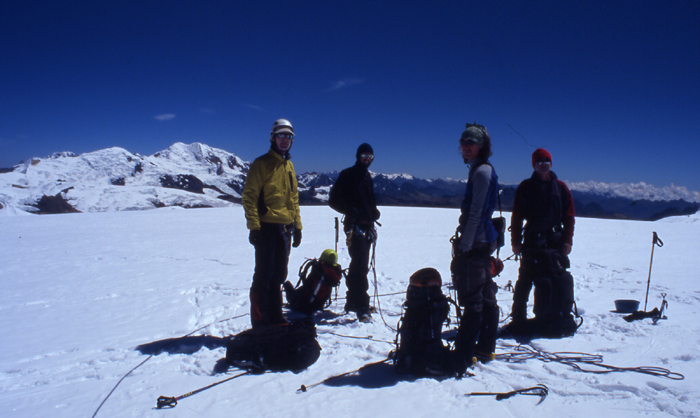
A group of climbers on the summit of San Braulio, southern Cordillera Vilcanota.
CUZCO
The former capital of the Inca Empire, Cuzco is one of the world's most fascinating cities. Many ruins from the days before the Spanish conquest of Peru are still visible in the city and surrounding foothills. There are countless examples of the Incas incredible skill as stone-masons. Huge granite blocks fit so well that a knife cannot be inserted between them. There are also some beautiful buildings in the city built by the early Spanish colonists, including the cathedral and buildings around the main square.
Because the city lies at an altitude of 3500m we'll spend four nights in Cuzco when we first arrive in Peru, getting used to the altitude. These acclimatisation days will give us time to explore many of the ruins in and around town. Highlight of these is the magnificent toothed fortress of Sacsayhuaman, which sits on a hillside above the city and is a rival even to Machu Picchu. There will also be the chance to visit the world famous site of Machu Picchu from the city on a long day trip by rail for those who are interested. (The cost of this option is not included).
Anyone with a big interest in Inca history is of course welcome to extend their own itinerary by several days, perhaps even including hiking the Inca Trail to Machu Picchu. We can give some help and advice if you wish to do this.
Please see our Cuzco and Machu Picchu page for more details of these well known sites
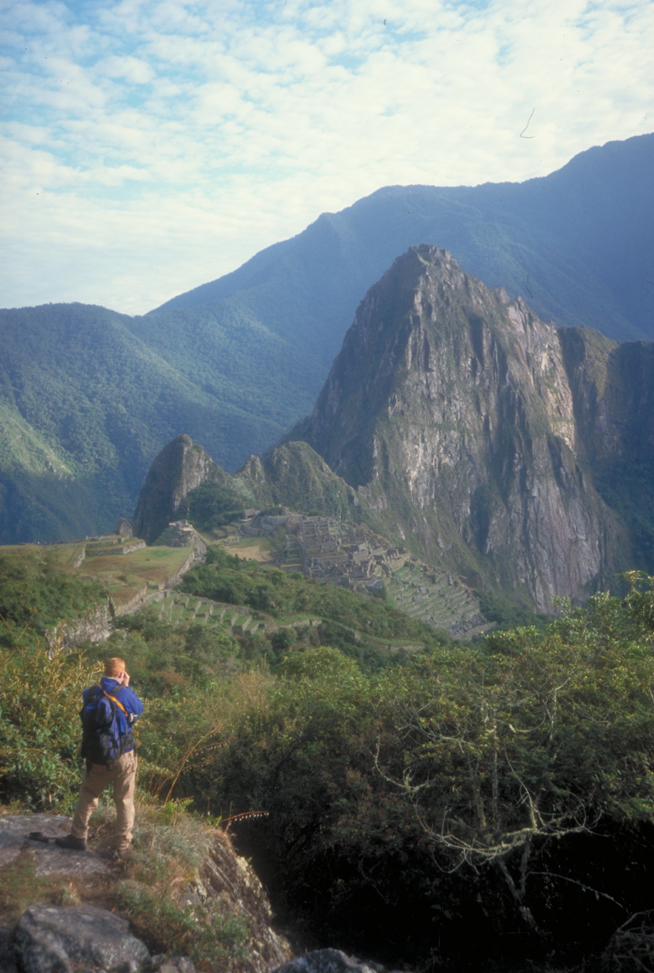
The ruins of Machu Picchu are located near Cuzco. It will be possible to visit this world famous archaeological site during our time in Cuzco as an optional day trip.
MACHU PICCHU
Machu Picchu (pictured above) was rediscovered by Hiram Bingham early this century when he was looking for a fabled 'lost' Inca city in the deep valleys around Cuzco. This is the most famous ruin in South America and not without reason. The setting is superb and the ruins themselves are extensive with many houses, temples and fortifications. The exact reason the Incas built Machu Picchu is not known (because they left no written records) but it was clearly a site of ceremonial importance. We can organise an optional day-trip excursion to Machu Picchu that will allow you a half day at the ruins. Please note however that this can be a long, tiring (and busy!) day.
THE CORDILLERA VILCANOTA
The Cordillera Vilcanota are a compact mountain range situated about 100km south east of Cuzco. They are perhaps the most rugged and remote mountains in Peru. The range contains several peaks over 6000m high, including Ausangate the highest peak at 6384m. The lower valleys that we trek through have been glaciated in the past and many small lochs remain behind. There are some idyllic campsites. Most of the valleys in the Vilcanota are still used as pastures by the Quechua speaking Indians and we are sure to see llamas and alpacas grazing. We will drive to the mountains using private hired vehicles, and then may use horses to get our equipment up to a base camp at Yanamayo, depending on the state of the roads, etc. Between our Yanamayo and Chimboya base camps we will again use private hire vehicles to travel.
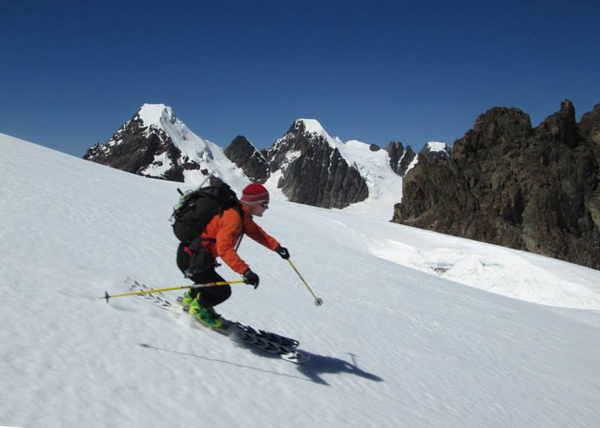
High altitude skiing at 5200m, in typical conditions for the Andes.
CLIMATE
This expedition is scheduled just at the end of the December-April wet season in this part of the Andes.By May there is normally very stable weather. However there can sometimes be windy days and we may get some light snow flurries. This time of year is early "winter" in Peru; during the day it normally feels pleasantly warm in the strong sunshine, but cool or cold if it gets windy. At night temperatures at altitude go down to -10ºC during almost 12 hours of darkness. Bring a warm sleeping bag and a good book!
EXPERIENCE AND FITNESS
Clients should be very experienced skiers and mountaineers. At least a little previous mountaineering experience, using an ice-axe and crampons, is essential. Expedition members need to be reasonably fit as we will be climbing and skiing at high altitudes. Climbing to well over 5000m is always hard physical work and the summit day on our biggest peaks are likely to be as much as 8-10 hours long. However we should stress that you don't need to be an olympic athlete!
Cold nights, cold washing water and some tinned and/or dried food are a few of the experiences which will have to be enjoyed or endured. Because this is a tropical ski trip it definitely won't be "ski-in, ski-out" and we'll have to carry skis and boots from our base camps in the mountain valleys to the snowline on almost all of our peaks. This will typically be for 1-1½ hours at either end of the day. We will be using either 4x4's or horses to help establish base camps where necessary, so you won't need to carry full expedition rucksacks at any stage.
INSURANCE, HEALTH & SECURITY
All clients must be insured for medical costs and repatriation in an emergency. We recommend having insurance for baggage, personal liability and cancellation as well. If you would like advice on insurance please ask. Peru is one of the less developed countries in South America and it is a good idea to avoid tap water, unwashed fruit, ice and all seafood. Vaccinations for tetanus, typhoid, polio and hepatitis are needed! Malaria and yellow fever precautions are not necessary as we won't be visiting mosquito infested areas. Peru is a very friendly and relatively safe country to visit but it is important to stay alert when in busy public areas and to guard your belongings carefully. Muggings and violent crime against tourists are very rare, but do happen. We issue further advice on security to all clients before departure.
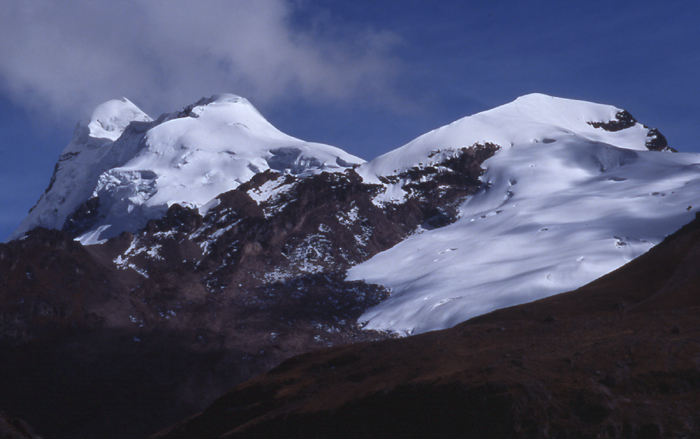
Mariposa with Mariposa Sur (5460m) on the right. Mariposa Sur is one of the peaks we are very likely to ski.
SAFETY AND RISK
This is an adventure holiday and all
clients will be exposed to hazards not found in
everyday life by taking part in this itinerary. While we take all
reasonable precautions to reduce risk it is neither possible nor desirable
to completely eliminate these hazards. It is important that you understand
the hazards you may be exposed to before
signing our booking form. We have identified the following areas as the
principal additional risks of this itinerary. (Some of
these could potentially result in serious injury or death). This is
not a fully inclusive list - a more
detailed risk assessment of this itinerary is available on our
Risk Assessments page, or phone/e-mail us
and ask some questions!
Driving, hotels and general safety : In
Peru driving, health, fire safety standards and general safety standards are
not as high nearly as in Europe.
Crime : Peru has a higher crime rate
than Europe. As a wealthy tourist you may attract attention.
Minor slips and falls : due to steep,
uneven and unstable ground. There is always a considerable risk of injury when skiing
off-piste due to the unpredictable nature of the terrain and snowpack.
Remoteness : You will be more than a days walk/drive from
professional medical help for periods of time throughout the expedition.
There is almost no chance of a helicopter rescue.
Altitude : At high altitudes there is an
increased risk of medical problems, most obviously altitude illness.
Mountain Hazards : In certain places you
may be subjected to a slight risk of rock slips. During and after stormy weather
there may be a risk of avalanche. There is also a risk from crevasse falls on
most of the ascents in this itinerary.
EXPEDITION ORGANISATION & LEADERSHIP
Our expeditions are designed to be small and flexible. The expedition will be co-ordinated, organised and lead by us, but we will consult expedition members when planning the details of the trip. We publish an outline itinerary so that we have a framework on which to build the expedition. Please note however that the leaders decision is final where the safety of the group or any member is in jeopardy; for example where retreat or diversion is necessary due to illness or bad weather.
In April 2025 this expedition is being organised and run in a collaboration between Andean specialist John Biggar (a WMCI and a Ski-mountaineer and Splitboarder) and IFMGA mountain guide Jim Blyth (on Telemark kit), who specialises in worldwide ski mountaineering activities.
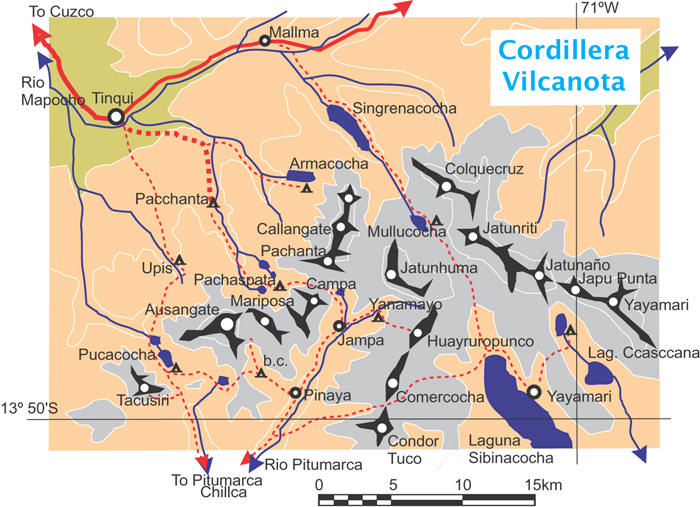

The main square in Cusco.

